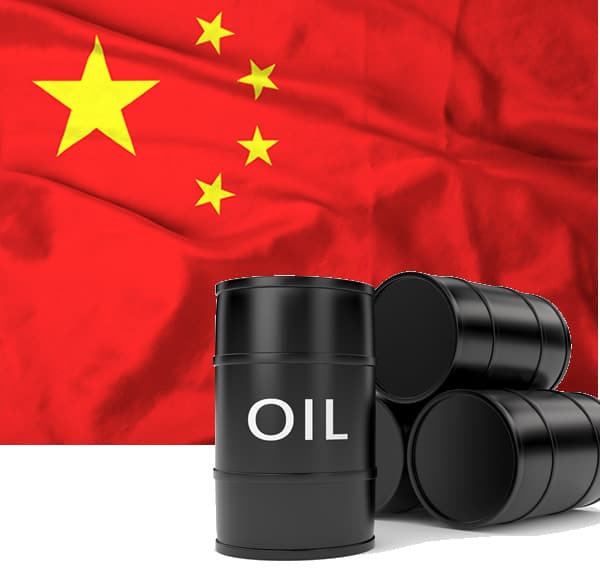Canada Becomes Key Oil Supplier As China Diversifies Away From US

Table of Contents
Geopolitical Factors Driving China's Diversification
China's decision to diversify its oil sources is not merely an economic choice; it's a strategic one rooted in geopolitical realities.
US-China Trade Tensions
The ongoing trade disputes and political tensions between the US and China have significantly impacted China's energy import strategy.
- Increased tariffs and trade sanctions: These measures have created uncertainty and instability in the US-China trade relationship, making reliance on US energy sources riskier.
- Political instability: The unpredictable nature of US-China relations adds another layer of complexity to China's energy security calculations, prompting a search for more reliable alternatives.
- Need for reliable and stable energy supplies: China's burgeoning economy demands a consistent and predictable flow of energy. Diversification minimizes disruption caused by potential political fallout with the US.
Energy Security Concerns
Beyond immediate trade tensions, China seeks to reduce its reliance on any single supplier for its vast energy needs. This is a core principle of national energy security.
- Risks associated with over-reliance on US oil imports: A dependence on one major supplier leaves China vulnerable to supply disruptions caused by political disagreements, natural disasters, or unexpected market fluctuations.
- Benefits of multiple sources of energy supply: Diversification mitigates these risks. Multiple suppliers provide greater resilience and stability in the face of unforeseen circumstances. This strategy reduces vulnerability and enhances China's energy independence.
Canada's Advantages as an Oil Supplier
Canada is uniquely positioned to benefit from China's diversification strategy. Several key factors contribute to its appeal as a reliable Canada oil supplier.
Abundant Oil Reserves
Canada possesses vast oil sands reserves, representing a significant potential source of energy for the global market, particularly China.
- Size and location of oil sands deposits: The Athabasca oil sands in Alberta are among the world's largest known oil reserves, offering a substantial and long-term supply.
- Production capacity and future expansion potential: Canada's oil production capacity is substantial and continues to grow, meeting the increasing demand from international markets like China.
Strong Bilateral Relations
The positive diplomatic ties between Canada and China foster a favorable environment for trade and energy cooperation.
- Existing trade agreements and investment opportunities: Existing trade agreements provide a framework for increased energy exchange, while investment opportunities further strengthen the economic partnership.
- Government support and initiatives fostering energy partnerships: Both Canadian and Chinese governments are actively promoting energy cooperation, providing incentives and support for joint ventures and projects.
Transportation Infrastructure
Efficient transportation infrastructure is critical for delivering Canadian oil to China.
- Existing and planned pipeline projects: Existing and planned pipelines, while facing ongoing debate, are vital for transporting oil from the oil sands to ports for export. New pipelines will also contribute to making Canada a more reliable and efficient oil supplier.
- Port capacity and shipping logistics: Canadian ports have the capacity to handle large volumes of oil exports, while established shipping routes ensure efficient transportation to China.
Challenges and Opportunities for Canada
While Canada enjoys considerable advantages, challenges remain in maximizing its role as a major Canada oil supplier.
Environmental Concerns
The environmental impact of oil sands extraction and transportation remains a significant concern.
- Greenhouse gas emissions and climate change implications: The extraction and processing of oil sands contribute to greenhouse gas emissions, raising climate change concerns.
- Canada's efforts towards sustainable energy practices and carbon reduction: Canada is actively investing in research and development of more sustainable energy extraction and transportation methods to mitigate environmental impacts and continue to grow as a responsible oil supplier.
Competition from Other Suppliers
Canada faces competition from other oil-producing nations seeking to supply the Chinese market.
- Key competitors and their respective strengths: Major oil-producing nations, such as Saudi Arabia and Russia, present significant competition with their own production capacities and pricing strategies.
- Strategies to maintain a competitive edge: To maintain its competitiveness, Canada must focus on cost-effectiveness, reliable delivery, and sustainable practices to remain a preferred oil supplier.
Conclusion
China's strategic diversification away from the US as its primary oil source presents a significant opportunity for Canada to establish itself as a key Canada oil supplier. Canada's abundant oil reserves, strong bilateral relations with China, and investments in infrastructure provide a solid foundation for increased energy trade. While environmental concerns and competition from other suppliers remain challenges, Canada's ability to address these issues will determine its long-term success. To remain competitive and secure its position as a leading Canada oil supplier, Canada must continue investing in sustainable energy practices, enhancing infrastructure, and fostering strong diplomatic ties with its key trading partners. The future of the global energy market increasingly hinges on the ability of countries like Canada to adapt and thrive in this evolving landscape.

Featured Posts
-
 Tarik Skubals Dominant Performance 7 Shutout Innings Against Brewers
Apr 23, 2025
Tarik Skubals Dominant Performance 7 Shutout Innings Against Brewers
Apr 23, 2025 -
 Tigers Frustrated By Questionable Plate Umpire Call Hinch Seeks Mlb Review
Apr 23, 2025
Tigers Frustrated By Questionable Plate Umpire Call Hinch Seeks Mlb Review
Apr 23, 2025 -
 Bank Of Canada Holds Rates Economists Weigh In Fp Video
Apr 23, 2025
Bank Of Canada Holds Rates Economists Weigh In Fp Video
Apr 23, 2025 -
 Diamondbacks Secure Walk Off Victory Against Brewers In Ninth
Apr 23, 2025
Diamondbacks Secure Walk Off Victory Against Brewers In Ninth
Apr 23, 2025 -
 Nine Home Runs Power Yankees Victory Judges Historic Night
Apr 23, 2025
Nine Home Runs Power Yankees Victory Judges Historic Night
Apr 23, 2025
